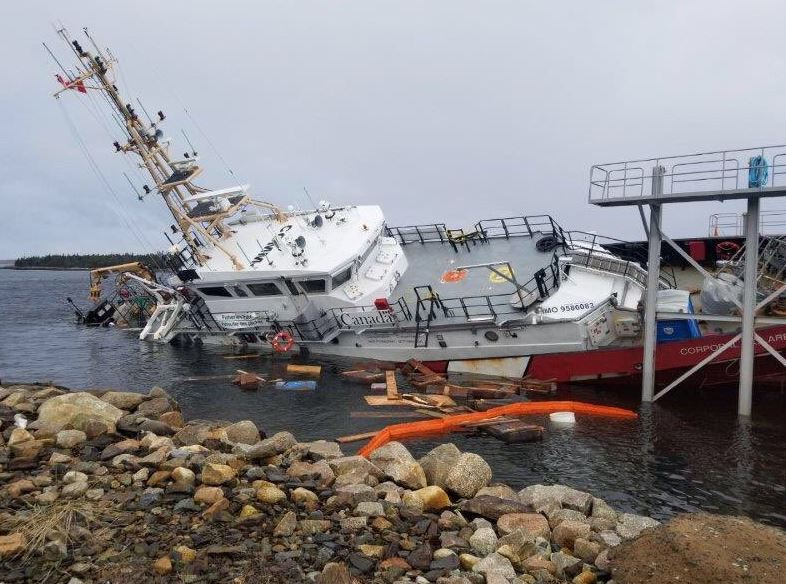A Canadian Coast Guard vessel sabotaged nine months ago will undergo expensive and lengthy repairs.

Global News has learned the CCGS Corporal McLaren has been patched up and towed to Halifax, where it is now at the Bedford Institute of Oceanography as it waits to be repaired.
In November 2018, the 42.8-metre-long patrol vessel was cut from its moorings at a dockyard in Sambro, N.S., where it was meant to be undergoing a month-long refit.
The vessel slipped from its cradle, crashing into the ocean floor and coming to rest partially submerged in the icy water of Sambro Harbour.
Power cables were torn from the vessel as it slid into the water. Multiple compartments on the vessel were filled with icy seawater, damaging computer equipment and rendering wiring useless.
READ MORE: No suspects, few leads as sabotaged Canadian Coast Guard vessel remains unrepaired
Officials were quick to determine the act was sabotage. Severed lines and snapped anchors reportedly indicated that someone had taken a power tool — possibly an angle grinder — to the cables holding it in place.
Internal emails obtained earlier this year by Global News indicate that security cameras at the shipyard had been unreliable in providing any leads.
RCMP said in April that no arrests had been made and no one had been charged. Halifax Regional Police have since taken over the investigation but have yet to respond to a request for comment.

Get breaking National news
CCGS Corporal McLaren — one of nine Hero-class vessels built for $227 million and launched from the Irving Shipyards in Halifax in 2013 — has now been moved to the Bedford Institute of Oceanography, where it is slated to undergo the repairs.
WATCH: Vandalism of coast guard vessel ‘upsetting’ and personal to namesake’s family members

Jane Kelsey, regional director of integrated technical services for the Canadian Coast Guard in Atlantic Canada, said the damage is believed to be “substantial” and that everything below the bridge deck was immersed in icy seawater, damaging computer equipment and rendering wiring useless
Everything that was damaged must now be replaced or refurbished, Kelsey said, but she was cautious when providing an estimate of how long the repairs could take.
“It’s difficult to estimate but it will not be near-term so it could be a year in here, a year and a half out. It’ll be really difficult for me to estimate that to any degree of accuracy,” Kelsey said in a phone interview.
The federal government is still formulating its repair plan and will have to tender any work that needs to be done.
Kelsey wouldn’t comment on what the repairs could cost, but preliminary estimates from observers at the time of the sabotage put a $5-million price tag on the project. Depending on what damage was discovered, that figure could now be significantly more or less.
Timothy Hiu-Tung Choi, a doctoral student at the University of Calgary’s Centre for Military and Strategic Studies specializing in maritime security and the Canadian navy, believes it could be significantly more.
“I imagine they’re in quite a pickle here,” said Choi, explaining that replacing everything below the waterline would likely mean replacing the most expensive and complex parts of the ship, such as the engines and generators.
“The repairs will likely be very expensive, to the point that many would wonder why they’re even bothering in the first place.”
Choi said the repairs won’t be the final step in getting CCGS Corporal McLaren up and running again, adding that it’s more realistic to expect a “return to service in no less than two years.”
The alternative would be to build a new ship entirely. But Canada is already committed to the National Shipbuilding Strategy, which would require a shipyard to build a “one-off vessel,” a project that would be both more expensive and take years, Choi says.
READ MORE: Waterlogged Coast Guard ship now being investigated as suspected vandalism
For now, the Canadian Coast Guard must make do with the vessels it currently has in service.
But Choi says that may cause its own problems, with the coast guard shuffling the refit and dry-dock schedules of each to ship to minimize the gaps in coverage caused by the sabotage of the McLaren.
“The fate of just one ship in the coast guard has effects that spill out across the entire fleet and to numerous yards and companies across the country.”
Choi added: “Such uncertainty over when the ships enter refit may result in increased costs due to various refit yards and services having to adjust their own schedules and supply chains.”
Kelsey said the Department of Fisheries and Oceans and the Canadian Coast Guard have been able to make do and will continue to do so until the CCGS Corporal McLaren is deployed once repairs are complete.
“Each one of our vessels, obviously, is an important part of the coast guard fleet,” she said.
“But during the period time that MacLaren has been unavailable for use, the coast guard has been using other fleet assets to continue to provide client services.”






Comments